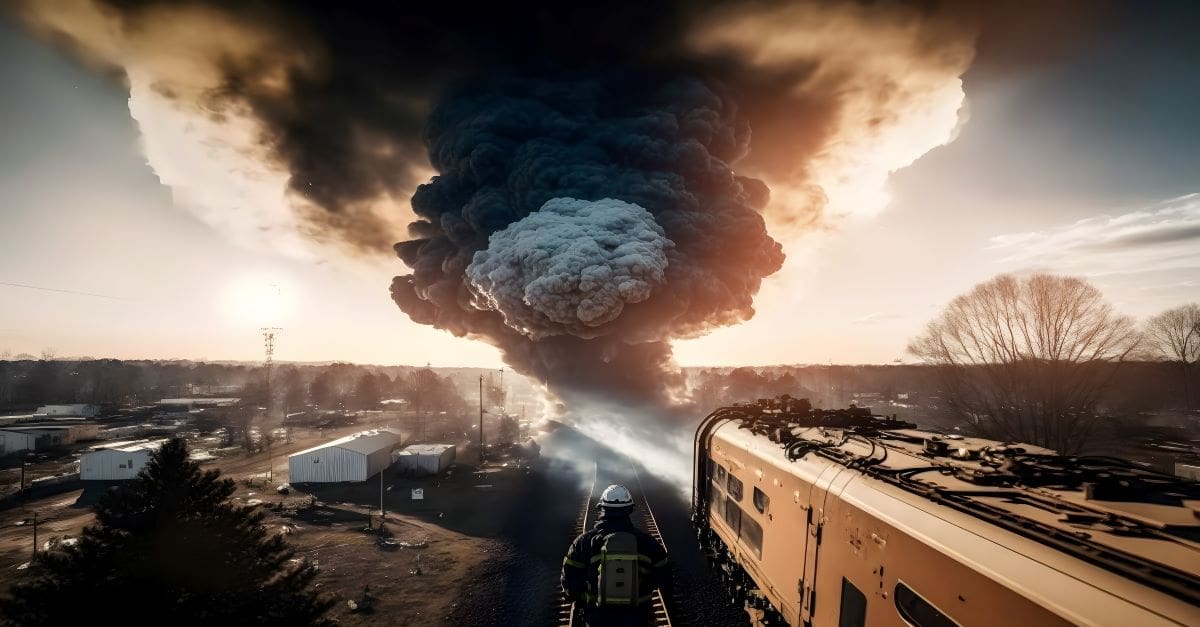
On Friday, February 3, 2023, at approximately 9:00 p.m., a Norfolk Southern Railway train carrying cargo from Madison, Illinois, to Conway, Pennsylvania, derailed in the small town of East Palestine, Ohio. A total of 38 cars derailed, and the fire that ensued damaged 12 others. This is normally the part of the story where the author would mention injuries and fatalities, but luckily, there were none reported.
This train headed to Pennsylvania wasn’t just any cargo train. There were 20 total hazardous material cars in the train, 11 of which derailed. Less than 72 hours after the accident, the Ohio Emergency Management Agency, fearing five of those derailed tankers were in danger of exploding, evacuated a one-mile by two-mile area around East Palestine and conducted a controlled release of the chemicals into a trough and set it on fire. Black smoke and flames filled the sky on the afternoon of February 6.
The chemical released in the air was vinyl chloride, a gas used to make plastic that the National Cancer Institute (NCI) classifies as a known human carcinogen, a substance capable of causing cancer. The small community of East Palestine is now left worrying about how much of their air, soil, and water has been contaminated and what health issues they may face in the future.
What is vinyl chloride?
Vinyl chloride is a manmade, volatile chemical compound used almost exclusively by the plastics industry to manufacture polyvinyl chloride (PVC), the hard resin used to make everything from pipes, packaging materials, vehicle upholstery, and children’s toys. In 2021, over 400,000 pounds of vinyl chloride was released into the air, with more than half of the total releases coming from just five plastic facilities, the worst emitter being Formosa Plastics Corp. in Texas, releasing more than 68,000 pounds of vinyl chloride in 2021.1
Most vinyl chloride that is spilled into the soil or surface water evaporates quickly. Once in the environment, vinyl chloride needs just a few days to break down by sunlight. If vinyl chloride reaches the groundwater, it will be broken down over time but can contaminate drinking water.
According to the Environmental Protection Agency (EPA), inhaling vinyl chloride can cause eye and respiratory irritation. At high levels, humans may experience loss of consciousness and it can have effects on the central nervous system.2 According to the NCI, vinyl chloride exposure is associated with an increased risk of hepatic angiosarcoma, a rare liver cancer, as well as primary liver cancer, brain and lung cancer, lymphoma, and leukemia.3
People who live near or work in factories that use and produce vinyl chloride will probably have the most exposure to vinyl chloride. People who live near landfills or toxic waste sites that leak vinyl chloride into their homes may also have higher exposure.
Environmental and health impact on East Palestine
Just two days after the controlled release of vinyl chloride, residents of East Palestine were told they could return to their homes after air and water quality samples tested by the EPA measured contaminants below the level of concern. However, on that same day, the Ohio Department of Natural Resources acknowledged the death of approximately 3,500 fish across 12 species and said the chemical spill has affected about seven and a half miles of streams.
One week after the derailment, residents of East Palestine were still reporting rashes and nausea, prompting the EPA to send in crews to test the in-home air quality of nearly 400 residents. Ten days after the accident, the EPA discontinued air monitoring for phosgene and hydrogen chloride, the chemical after-effects of burning vinyl chloride.
On February 14, the Chief of the Division of Surface Water at the Ohio EPA declared that no vinyl chloride was detected in any down-gradient waterways near the derailment site. However, some waterways remained contaminated, specifically Sulphur Run, a creek in East Palestine, but the agency was confident the contaminants were contained.
Another week later, on February 21, the state of Ohio opened a public health clinic for residents who worry lingering symptoms might be linked to the derailment. During the week of February 27, scientists from Texas A&M University and Carnegie Mellon University released an analysis suggesting that nine out of the dozens of chemicals the EPA has been monitoring are still at levels higher than what would normally be found in East Palestine, but still below the risk level.
One month after the train derailment, the Ohio governor’s office released the results of a health assessment survey from East Palestine. Among the 170 participants observed by a doctor, 74 percent reported headaches, 63 percent reported anxiety, 61 percent reported coughing, 58 percent reported fatigue, and 52 percent reported irritation or pain of their skin.4 Investigations are still underway to determine whether any lingering health conditions reported are linked to the derailment.
Local labs played a large role in understanding the level of contamination
With the demand to understand what was contaminated in and around East Palestine, several local environmental laboratories stepped up to assist with testing.
The Cardinal Environmental Lab in Youngstown, Ohio, ran roughly 10 years’ worth of water samples in just two weeks, testing the drinking water for vinyl chloride and benzene.5 Pace Labs in Indiana conducted soil testing for dioxins from loads of contaminated soil coming from the derailment site. Dioxins form when chemicals like vinyl chloride are burned and settle into the soil.6 The Pennsylvania Department of Health Resource Center also offered nearby residents free, independent water testing and guidance on food and animal safety.7
The CEO of Alloway Labs in Marion, Ohio, John Hoffman, even walked door-to-door in East Palestine offering his lab’s water testing services in hopes of giving residents peace of mind or a second opinion.8
References
1https://enviro.epa.gov/triexplorer/chemical.html?pYear=2021&pLoc=0000075014&pParent=TRI&pDataSet=TRIQ1
2 https://19january2017snapshot.epa.gov/sites/production/files/2016-09/documents/vinyl-chloride.pdf
3 https://www.cancer.gov/about-cancer/causes-prevention/risk/substances/vinyl-chloride
4 https://www.cnn.com/2023/03/03/us/ohio-train-derailment-east-palestine-Friday
5 https://www.news5cleveland.com/news/east-palestine-train-derailment/youngstown-lab-testing-for-vinyl-chloride-seeing-high-demand-from-east-palestine
6 https://www.in.gov/idem/featured-topics/east-palestine,-ohio-soil-sampling-results/
7 https://www.timesonline.com/story/news/local/2023/02/27/where-can-you-find-resources-after-east-palestine-train-crash-beaver-county-ohio-pennsylvania/69937651007/
8 https://www.cbsnews.com/pittsburgh/news/ceo-of-alloway-in-ohio-offers-water-testing-to-residents-in-east-palestine/




